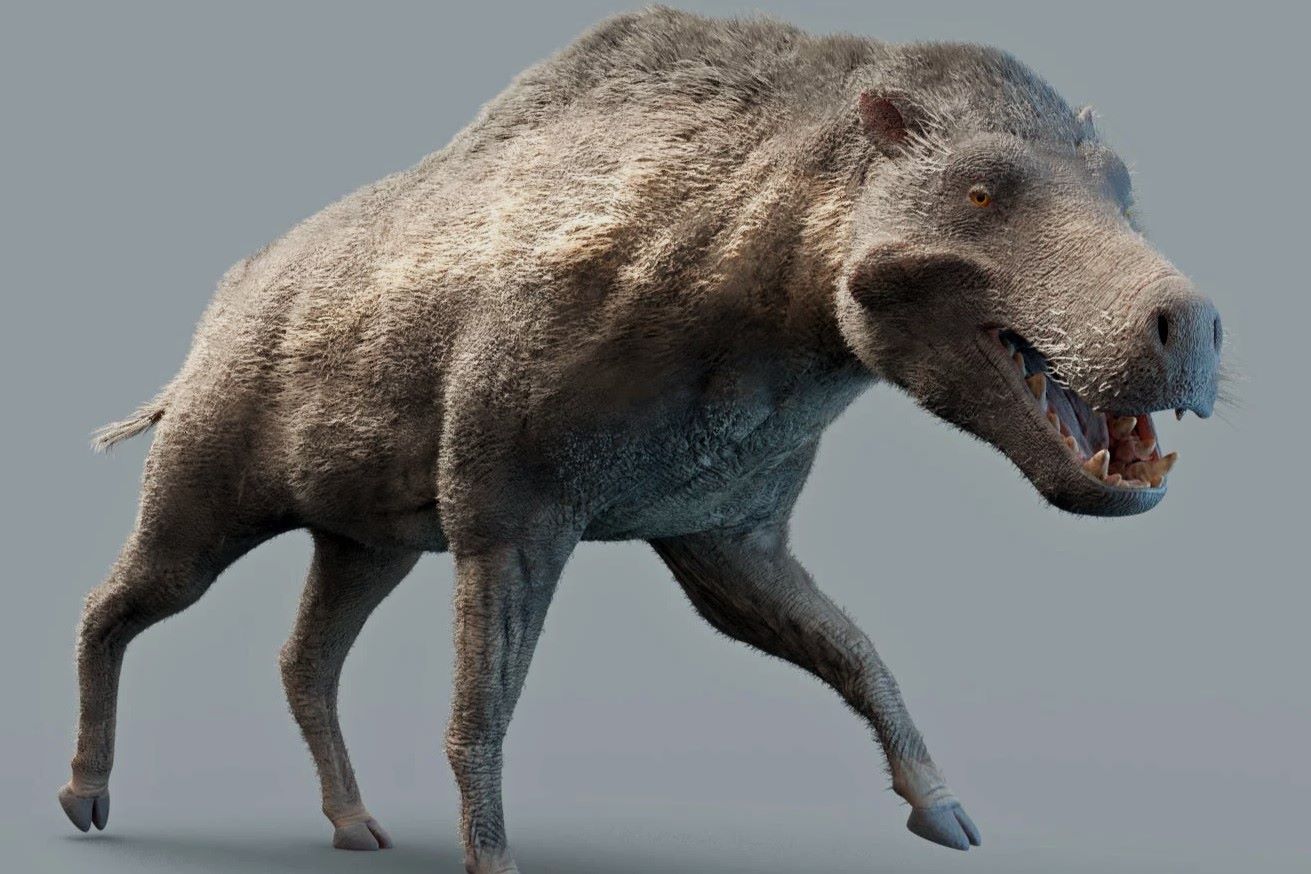
Entelodonts, often called "hell pigs" or "terminator pigs," were prehistoric creatures that roamed Earth millions of years ago. Despite their pig-like appearance, they were more closely related to hippos and whales. These fascinating beasts had massive jaws, sharp teeth, and a robust build, making them formidable predators and scavengers. Entelodonts thrived during the Eocene to Miocene epochs, adapting to various environments. Their unique features, such as bony lumps on their cheeks and elongated snouts, set them apart from other ancient mammals. Curious about these ancient giants? Here are 40 intriguing facts about Entelodonts that will transport you back to a time when these fearsome creatures dominated the landscape.
Key Takeaways:
- Entelodonts, also known as "hell pigs," were massive, omnivorous mammals with powerful jaws and a fearsome appearance. They lived 37 to 16 million years ago and are more closely related to hippos and whales than modern pigs.
- Fossils of entelodonts provide valuable insights into prehistoric ecosystems and the evolution of large mammals. Despite their extinction, they continue to captivate scientists and the public, serving as a reminder of Earth's diverse and adaptable life.
What are Entelodonts?
Entelodonts, often called "hell pigs" or "terminator pigs," were prehistoric mammals that roamed the Earth millions of years ago. These creatures were part of the Entelodontidae family and are known for their unique and somewhat terrifying appearance.
-
Entelodonts lived during the Eocene to Miocene epochs, which means they existed around 37 to 16 million years ago.
-
They were omnivores, meaning they ate both plants and animals. Their diet likely included roots, fruits, small mammals, and carrion.
-
Entelodonts had large, powerful jaws with teeth designed for crushing bones. This feature allowed them to consume a wide variety of foods.
-
Their skulls were massive, often making up a third of their body length. This gave them a fearsome look and a powerful bite.
-
Despite their pig-like appearance, entelodonts are more closely related to hippos and whales than modern pigs.
Physical Characteristics of Entelodonts
Entelodonts had several distinct physical traits that set them apart from other prehistoric mammals. These features made them formidable creatures in their environment.
-
They could grow up to 6.9 feet tall at the shoulder, making them one of the largest terrestrial predators of their time.
-
Entelodonts had long, slender legs, which suggests they were capable of running at high speeds to chase down prey or escape danger.
-
Their bodies were robust and muscular, providing them with the strength needed to overpower other animals.
-
The snout of an entelodont was elongated, ending in a flat, broad nose that helped them root for food.
-
They had bony protrusions on their cheeks and jaws, which may have been used for display or combat with other entelodonts.
Behavior and Lifestyle
Understanding the behavior and lifestyle of entelodonts gives us insight into how they survived and thrived in their prehistoric world.
-
Entelodonts were likely solitary animals, coming together only to mate or compete for resources.
-
They were highly territorial, using their size and strength to defend their home ranges from other predators.
-
Entelodonts may have engaged in scavenging, using their powerful jaws to break open bones and access marrow.
-
Their keen sense of smell helped them locate food over long distances, an essential trait for survival.
-
Entelodonts had a relatively short lifespan, with most individuals living only 10 to 15 years.
Fossil Discoveries
Fossils of entelodonts have been found in various parts of the world, providing valuable information about these ancient creatures.
-
The first entelodont fossils were discovered in the 19th century, sparking interest and debate among paleontologists.
-
Fossils have been found in North America, Europe, and Asia, indicating that entelodonts had a wide geographic range.
-
Some of the best-preserved fossils come from the Badlands of South Dakota, where entire skeletons have been unearthed.
-
Fossilized footprints of entelodonts have been found, giving clues about their gait and movement.
-
Skull fossils show evidence of injuries, suggesting that entelodonts engaged in combat with each other.
Extinction of Entelodonts
Like many prehistoric creatures, entelodonts eventually went extinct. Several factors likely contributed to their disappearance.
-
Climate change played a significant role, as the Earth underwent significant cooling and drying during the Miocene epoch.
-
Competition with other predators may have also contributed to their decline, as new species evolved and competed for the same resources.
-
Changes in vegetation affected their food supply, making it harder for entelodonts to find enough to eat.
-
Human activity did not contribute to their extinction, as entelodonts disappeared long before humans appeared on the scene.
-
Their extinction marked the end of the Entelodontidae family, leaving no direct descendants in the modern world.
Interesting Facts about Entelodonts
There are many fascinating tidbits about entelodonts that highlight their unique place in prehistoric history.
-
Entelodonts are sometimes called "terminator pigs" due to their fearsome appearance and predatory nature.
-
They had a bite force comparable to that of a modern-day crocodile, capable of crushing bones with ease.
-
Entelodonts had a relatively small brain compared to their body size, suggesting they relied more on brute strength than intelligence.
-
Their teeth were highly specialized, with some designed for slicing meat and others for grinding plant material.
-
Entelodonts are often depicted in popular media, including documentaries and video games, due to their striking appearance.
The Legacy of Entelodonts
Though they have been extinct for millions of years, entelodonts continue to capture the imagination of scientists and the public alike.
-
Paleontologists study entelodonts to understand predator-prey dynamics in prehistoric ecosystems.
-
Their fossils provide clues about the environment and climate of the time periods in which they lived.
-
Entelodonts are used as a reference point for studying the evolution of other large mammals.
-
They serve as an example of how diverse and adaptable life on Earth can be, even in the face of changing conditions.
-
Museums around the world display entelodont fossils, helping to educate the public about these fascinating creatures.
Modern Comparisons
While no modern animals are direct descendants of entelodonts, there are some interesting comparisons to be made.
-
The closest living relatives of entelodonts are hippos and whales, despite their vastly different appearances.
-
Modern pigs share some superficial similarities, such as their snouts and omnivorous diet, but are not closely related.
-
Entelodonts' role as apex predators can be compared to that of modern big cats, such as lions and tigers.
-
Their scavenging behavior is similar to that of hyenas, which also have powerful jaws for breaking bones.
-
Studying entelodonts helps scientists understand the evolution of large mammals, shedding light on how different species adapt to their environments.
Final Thoughts on Entelodonts
Entelodonts, often called "hell pigs," were fascinating creatures that roamed the Earth millions of years ago. These prehistoric animals had unique features like large jaws, robust teeth, and a bulky build, making them formidable predators and scavengers. Their fossils have provided valuable insights into their behavior, diet, and habitat, helping scientists piece together the puzzle of their existence.
Despite their fearsome appearance, entelodonts played a crucial role in their ecosystems, contributing to the balance of predator and prey dynamics. Their extinction, like many other prehistoric species, remains a subject of study, offering lessons about evolution and environmental changes.
Understanding these ancient creatures not only satisfies our curiosity about the past but also enriches our knowledge of the natural world. Entelodonts remind us of the incredible diversity of life that has existed on our planet and the ever-changing nature of life on Earth.
Frequently Asked Questions
Was this page helpful?
Our commitment to delivering trustworthy and engaging content is at the heart of what we do. Each fact on our site is contributed by real users like you, bringing a wealth of diverse insights and information. To ensure the highest standards of accuracy and reliability, our dedicated editors meticulously review each submission. This process guarantees that the facts we share are not only fascinating but also credible. Trust in our commitment to quality and authenticity as you explore and learn with us.


